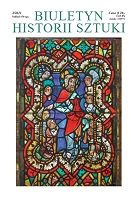Malarski wystrój pałacu w Radzyniu Podlaskim i rola Jana Bogumiła Plerscha
Painting Décor of the Radzyń Podlaski Palace and the Role of Jan Bogumił Plersch
Author(s): Aleksandra BernatowiczSubject(s): Museology & Heritage Studies, Visual Arts, History of Art
Published by: Instytut Sztuki Polskiej Akademii Nauk
Keywords: Rococo; Painting Décor; Wall Paintings; Supraportres (Overdoors); Jan Bogumił Plersch; Jakub Fontana; Radzyń Podlaski Palace;
Summary/Abstract: The unpreserved interiors of the Potocki palace in Radzyń Podlaski designed by Jakub Fontana were one of the last original manifestations of Rococo aesthetics in Poland. The decoration was characterized by moderate ornamentation, a clear articulation of white panelling with the use of gilded moulds, frames, and pilaster strips, as well as overdoors in fancy, yet symmetrical frames. Some of the rooms were given wall decoration, according to archival records possibly executed entirely by Jan Bogumił Plersch, the main (however not only) painter employed for the palace’s decor. He was also most likely the one to execute the overdoors whose affiliation with definite interiors as well as the definition of the significance in the whole decoration structure is undertaken by the Author: seascapes, mountain views, pastoral scenes, and compositions with fruit and flowers shown against park vistas. The latter reveal the closest affinity with still lifes of the French painter Augustin Dubuisson who decorated Sanssouci and the Royal Palace in Wrocław. The seascapes, instead, may have been modelled on Dutch prints, and were a reflection of Hollandism, a vogue imported from France of the time. Therefore, French affiliations are an important feature in the painting decoration of the Radzyń palace, though in Fontana’s genuine design no direct model for it can be identified. Some of Plersch’s paintings are of a metaphorical undertone, and find their ideological confirmation in the decoration of the Palace’s elevation: the idea of a knight’s residence manifested with the use of panoplies in the Ball Room polychrome and the concept of a palace as a shrine of beauty and art, clear in the overdoors decorating the Library, and showing liberal arts, as well as Civil and Military Architecture. The programme made reference to the pax et belum topos: heroic accomplishments of the ancestors were balanced by emphasizing peaceful initiatives of Eustachy Potocki, owner of the residence at the time.
Journal: Biuletyn Historii Sztuki
- Issue Year: 83/2021
- Issue No: 2
- Page Range: 377-424
- Page Count: 48
- Language: Polish

